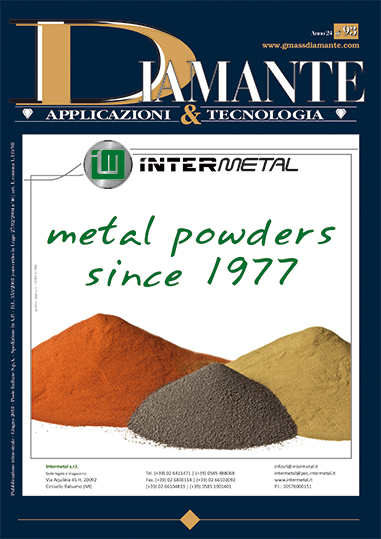|
Diamante A&T Contents Year XIV - June 2018 |
|||||
|
Front Cover: INTERMETAL S.r.l Intermetal has lived many evolution phases during its first 40 years, but the common denominator has been the metallurgy applied in many industrial fields since 1977. Intermetal’s main business has in fact always been and still firmly is supplying of metal powders for the diamond tool industry. In the spotlight 08) Marmomac 2018, business and culture at Veronafiere expands the natural stone global community Diamond Tools 17) Innovative optimization in the diamond wire cutting process in quarries by Fravizel S.A., Alcanede, Portugal
Abstract: In the last 10 years the squaring phase in the natural stone extraction has evolved by means of the innovation and the technology used in the machines, that has led to an increase of productivity. Diamond wire is everyday more efficient, with more quality and better adapted to the stone characteristics. Combined with machines, that allow a correct definition of parameters according to stone characteristics it has given the rightful contribution making diamond wire cutting a preferable cutting method. Arising from this evolution is the need for the constant optimization of processes and resources resulting
in the development of a new machine concept for this squaring phase. Stone 22) Life Cycle Inventory of dimension stone supply chain technologies by Isabella Bianco, Gian Andrea BlenginiPolitecnico di Torino, Italy
Abstract: The dimension stone sector is more and more active in developing new solutions to improve the sustainability of its supply chain, partly as a consequence of the current EU policies on Circular Economy and Raw Materials. The Life Cycle Assessment (LCA) is a recognized scientific tool for evaluating environmental impacts of the processes. Nevertheless, in the stone sector, LCA is hindered by the scarce availability of Life Cycle Inventory (LCI) datasets for the specific technologies of the stone supply chain. 28) A new scientific approach to determine the stone workability by Lorena Zichella, Rossana Bellopede, Fiorenza Baudana, Paola MariniPolitecnico di Torino, DIATI, Turin, Italy
Abstract: The prediction of stone-diamond wire interaction is important for the extractive sector, both to improve the productivity and efficiency of quarry work and to avoid dangerous and expensive endeavours of cutting when an unknown stone has to be introduced in the plant. Combining two simple test as the measurement of ultrasonic pulse velocity of the stone and the Knoop micro hardness, a scientific classification of workability have been found. In particular, in this work the application of this scientific classification methodology to the stone plant has been studied, performing UPV measurements on stone block before their cutting. The correlation of ultrasonic measurements by indirect method with the index HK25 allowed to order the stones in classes of workability that correspond to what the owners of the plant used to give to such stones. Moreover the correspondence with the in situ cutting parameters has confirmed the reliability of this scientific methodology. 34) Imperial blue quartzite characterization purposing the removal of natural stains by J.T. Zagoto1, R.D. Teixeira1, B.V. Miotto1, B.G. Rocha2, H.S. De Paula31 Instituto Federal Espírito Santo, Campus Nova Venécia, Espírito Santo, Brasil 2 Instituto Federal do Espírito Santo, Campus Nova Venécia (Bolsista CNPq), Espírito Santo, Brasil 3 Universidade Federal do Vale do Jequitinhonha e Mucuri, Campus Janaúba, Minas Gerais, Brasil
Abstract: The blue quartzite of the Serra do Espinhaço, Northern of Bahia is marketed under different commercial names, such as: “Azul Imperial”, “Azul Boquira” and “Azul Macaúbas”. The bluish color, which generates the exotic features to the rock, comes from the minerals rich in boron, mainly the dumortierite. This ornamental stone has high market value and, currently, has a great demand for this type of rock, mainly for export. However, in some portions of this stone pit, there are stain spots of yellowish to reddish tones that cause the final price of the benefited rock (slabs) to lose up to 40% of its market value. Thus, the purpose of this work aims to characterize this material in order to identify the minerals that cause the stains and provide a chemical treatment capable of returning the market value to the rock. For this purpose, characterization tests were used, such as: petrographic description of rock samples, X-ray fluorescence (FRX) and X-ray diffraction (XRD). Analyzes showed a presence of minerals containing Iron
(Fe), Aluminum (Al) and Titanium (Ti), possible causes of such changes in rock coloration. 41) Application of castor oil polyurethane resin in the dimension stone block resin infusion process by Leonardo Luiz Lyrio da Silveira1, Bruna dos Santos Cezar Ferreira2, Phillipe Fernandes de Almeida31 Centro de Tecnologia Mineral, NR-ES/CETEM-MCTIC, Cachoeiro de Itapemirim, Brasil 2 Federal Institute of Espirito Santo, Department of Mining Engineering, Cachoeiro de Itapemirim, Brasil 3 University of Sao Paulo, Department of Architecture and Urbanism, São Carlos, Brasil
Abstract: The resin infusion of dimension stone block is a step in the process of stone processing that aims to provide increased physical-mechanical resistance to the block, thus ensuring that the process occurs safely and without damaging the geometry of the slabs obtained. Therefore, in order to increase the eco-efficiency of this sector, the search for an alternative to the use of epoxy resin, whose compounds are not in accordance with the sustainability precepts, by an ecological non-toxic castor oil-based resin may provide a global market variance of Brazilian materials. For this, the tensile strength of the resins in carbonaceous and silica materials was measured, observing their respective behaviors. The results obtained were satisfactory, showing that the castor oil resin showed good behavior in relation to the tensile stresses in the stone block resin infusion process. These results allow one to infer that the use of castor oil resin to replace the epoxy resin currently used will lead to an environmental gain to this stage of dimension stone processing. 46) Concrete production using slate wastes by L.B. Palhares, P.R.P. de Paiva, M.A.D. Rodrigues, V.C. Gonçalves, S.B.P. da SilvaCentro Federal de Educação Tecnológica de Minas Gerais (CEFET), Departamento de Engenharia de Materiais, Brasil
Abstract: The system of slate extracting blocks and its final machining operations generate a large amount of waste (~75% of the extracted rock). The plate extraction system generates a significant amount of waste in the form of a sludge composed mainly of water, lubricants and crushed rock. This waste with no defined destination accumulates in yards, reservoirs and streams, affecting the ecosystem causing technical, economic, environmental and social problems. Due to the physical and chemical properties of slate, the waste has great potential for recovery and recycling. In this paper is described the production of concrete with slate additions. The addiction of 15% shows that mechanical strength increased 38% compared to the reference concrete and water absorption approximately 20%. The works here developed have shown that all processing used need a control of slate particle size and others properties. The slate powder is promising for use in ceramic, concrete and new materials. News & Events 51) Middle East Stone Expo to host record number of stone suppliers as show doubles in size for 2018 54) Xiamen Stone Fair 2018. Closer international cooperation and more business opportunities 56) Marble 2018 stimulated economy. Buyers and sellers having made million-dollar agreements were pleased with the show 60) INTERMAT 2018: a wave of innovation heralding new business 76) 31st BI-MU, great success in the collection of applications 4 months before the eventConcrete Cutting 64) Massive wire sawing project at hydroelectric dam 72) Tyrolit for infrastructural reconstruction. Fossano's Beltway: design the deconstruction |
|||||

